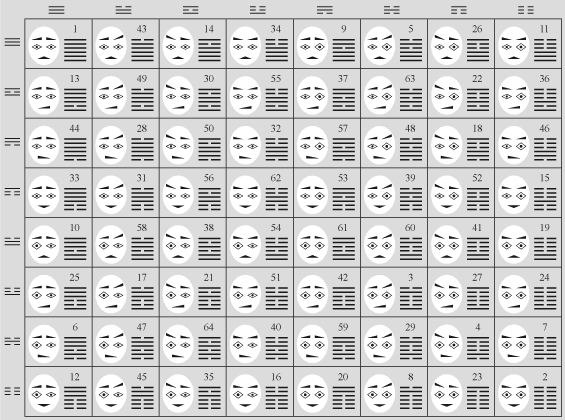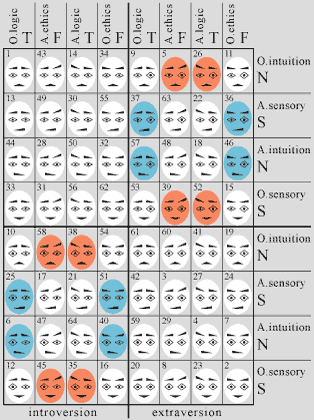Hexagrams of the canon of changes IChing are logic system which coincides with physiognomy of a human face, namely coincides with physiognomic system of facial features, and also coincides with system of psychological parameters which are caused by asymmetry of hemispheres of a brain. Therefore hexagrams IChing are universal symbols which allow to systematize psychological parameters of a human person and allow to organize psychological types and physiognomic images of psychological types by means of the regular table, as shown below.

In the table hexagrams IChing are located as a square according to
trigrams which are shown above and at the left, namely the top three
lines in hexagrams IChing correspond to trigrams above the table, and
the bottom three lines in hexagrams IChing correspond to trigrams at the
left of the table. Total is 64 hexagrams which correspond to 64
psychological types.
Figures show serial numbers of hexagrams in a sequence of the Book of
Changes IChing, and accordingly psychological types have serial numbers
similar to hexagrams.
To everyone hexagram IChing there corresponds the symbolical
physiognomic image of a human face which is a symbol of the appropriate
psychological type, and also is visual image according to which it is
possible to identify psychological type from the view point of ratio of
physiognomic attributes or symbolical features of a face with
psychological parameters of a human person.
Sad (unvigor) eyebrows specify attributes of obvious logic function; joyful
(vigor) eyebrows specify attributes of obvious ethical function; the right
joyful eyebrow and the left sad eyebrow specify attributes of active
logic function; the left joyful eyebrow and the right sad eyebrow
specify attributes of active ethical function.
Small eyes specify physiognomic attributes of obvious introversion; the
big eyes specify attributes of obvious extraversion; the right big eye
and the left small eye specify attributes of active introversion; the
left big eye and the right small eye specify attributes of active
extraversion.
The sad mouth specifies physiognomic attributes of obvious intuitive
function; the joyful mouth specifies attributes of obvious sensory
function; the right joyful corner of a mouth and the left sad corner of
a mouth specify attributes of active intuitive function; the left joyful
corner of a mouth and the right sad corner of a mouth specify attributes
of active sensory function.
In total shown table unites C. G. Jung's psychological types,
psychological types of socionics and I. Brigs-Majers's typology, and also
shows psychological types which are not taken into account in socionics
and I. Brigs-Majers's typology. That is possible to see in the following
table where red and blue color marks cells which correspond to 16
psychological types of socionics and I. Brigs-Majers's typology in common
number of 64 psychological types of analytical physiognomy:
 |
Verticals of the table correspond with logic and
ethical mental functions: 1st and 5th verticals - obvious logic function; 2nd and 6th verticals - active ethical function; 3rd and 7th verticals - active logic function; 4th and 8th verticals - obvious ethical function. Horizontals of the table correspond with intuitive and sensory mental functions: 1st and 5th horizontals - obvious intuitive function; 2nd and 6th horizontals - active sensory function; 3rd and 7th horizontals - active intuitive function; 4th and 8th horizontals - obvious sensory function. The left half of table (verticals from 1st up to 4th) corresponds with introversion and the right half of table (verticals from 5th up to 8th) corresponds with extraversion, and in particular: - the top left quarter corresponds with obvious introversion; - the bottom left quarter corresponds with active introversion; - the top right quarter corresponds with active extraversion; - the bottom right quarter corresponds with obvious extraversion. |
In I. Brigs-Majers's typology the following letter designations are
accepted:
F - ethical function;
T - logic function;
N - intuitive function;
S - sensory function;
I - introversion;
E - extraversion;
J - rationality;
P - irrationality.
Names of psychological types write down by means of four letters:
- the first letter specifies introversion or extraversion;
- the second letter specifies logic or ethical function;
- the third letter specifies intuitive or sensory function;
- the fourth letter specifies rationality or irrationality.
For example: ETSJ - extraverted-logic-sensory-rational type.
In socionics psychological parameters designated by letters:
E - extraversion;
I - introversion;
L - logic function;
E - ethical function;
I - intuitive function;
S - sensory function.
Names of psychological types in socionics write down by means of three letters:
- the first letter specifies conducting mental function;
- the second letter specifies minor mental function;
- the third letter specifies introversion or extraversion.
For example: SLI - sensory-logic introverted type.
If the first letter specifies rational mental function (logic or ethics) then
the psychological type is rational, and if the first letter specifies irrational
mental function (intuition or sensory) then the psychological type is
irrational. Namely rationality or irrationality of psychological type are specified by means of letters J or P
in I. Brigs-Majers's typology, but in socionics rationality or irrationality is meant according to conducting mental
function which is specified by the first letter in the name of psychological
type.
In detail 16 psychological types of socionics and I. Brigs-Majers's typology
are listed on the following page.
Basic property of psychological types in socionics and I. Brigs-Majers's
typology is presence of conducting mental function and minor mental function. If
conducting function is rational then minor function is irrational, and if
conducting function is irrational then minor function is rational. And
accordingly psychological types are rational or irrational according to
conducting function.
Therefore in socionics and I. Brigs-Majers's typology there are 16 psychological
types from 64 possible types, that is possible to see in the table. As
conducting mental function should be active and minor mental function should be
obvious, and only in this case the psychological type is rational or irrational.
And if both functions are active or both functions are obvious then it is
impossible to determine conducting function, and accordingly it is impossible to
speak about unconditional rationality or irrationality of psychological type.
And also basic property of psychological types in socionics and I. Brigs-Majers's
typology is unconditional introversion or extraversion that corresponds with an
active left eye or an active right eye. But if eyes are identical then it is
impossible to speak about unconditional introversion or extraversion.
In the table red color marks rational types and blue color marks irrational
types which correspond to typological criteria of socionics and I. Brigs-Majers's
typology, namely red and blue psychological types have conducting active mental
function and minor obvious mental function, and accordingly these types are
certainly rational or irrational. And also red and blue psychological types have
active extraversion or active introversion. But other psychological types do not
correspond criteria of socionics and I. Brigs-Majers's typology, but other types
form the big system or the big square table of 64 psychological types of
analytical physiognomy.
Rules of identification of 64 psychological types in the square table consist in
the following.
The logic type has active logics which is conducting mental function and
is specified by an active right eyebrow.
The ethical type has active ethics which are conducting mental function
and is specified by an active left eyebrow.
The intuitive type has active intuition which is conducting mental
function and is specified by an active right corner of a mouth.
The sensory type has active sensorics which is conducting mental function
and is specified by an active left corner of a mouth.
If the psychological type has two active mental functions then conducting
function does not exist, and also if all mental functions are obvious and
unobvious then conducting function does not exist.
Rational types have active logics or ethics, namely have active
rational mental function, and intuition or sensorics are obvious.
Irrational types have active intuition or sensorics, namely have active
irrational mental function, and the logics or ethics are obvious.
If the psychological type has active rational mental function and active
irrational mental function then it is impossible to speak about rationality or
irrationality of type. And also if all mental functions are obvious and
unobvious then it is impossible to speak about rationality or irrationality of
type.
Extraverted types have active extraversion which is specified by an
active left eye and a passive right eye.
Introverted types have active introversion which is specified by an
active right eye and a passive left eye.
If eyes are symmetric then the psychological type is not certainly
extraverted or introverted.
The following page gives the further description of square table of 64 psychological types and 16 psychological types of socionics and I. Brigs-Majers's typology.